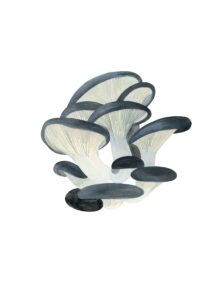 Life in the Margins: The Intersection of Sylvia Plath and the Study of Fungi
Life in the Margins: The Intersection of Sylvia Plath and the Study of Fungi
By Emilia Neyer (’26)
Despite the societal tendency to polarize the sciences and the humanities, the Smith College mycology professor Dr. Sara Bache-Wiig and the poet Sylvia Plath defy this construct. They are inextricably tethered to one another, like strands of mycelia beneath the forest floor, in their breathtaking intellect and shared ties to Smith. However, perhaps they are most closely aligned in their marginalization, whether that be in the study of science, the world of poetry, or the oppressively patriarchal society in which they lived. In this marginalization, Bache-Wiig and Plath evoke humanity’s closest biological kin, fungi, which have thrived in the ecosystemic margins for millennia. Thus, it is by turning to our fungal kin that we may better understand the nuanced identities of women like Bache-Wiig and Plath and, in doing so, reinforce their legacies.
As the primary decomposers in all terrestrial ecosystems, fungi and their fruiting bodies, mushrooms, are predominantly relegated to the margins of the forests and fields where they spawn. Indeed, in “Unruly Edges: Mushrooms as Companion Species,” multispecies anthropologist Anna Tsing (2011: 151) details how “the mushrooms we eat congregate at edges… Many favoured mushrooms flourish in agrarian seams: between fields and forest, and at the margins of zones of cultivation.” Fungal populations are thrust into areas marked by disturbed soils and the buildup of organic matter, left to fill the undesirable niches left vacant by other species.
Just as fungal decomposers are marginalized through their common reputation as less glamorous and less charismatic than their plant and animal counterparts, Sylvia Plath suffered marginalization in her professional endeavors as a result of her sex. While Plath’s personal correspondence and private life are valuable testaments to her experiences of social inequity, her observations of female marginalization in mid-twentieth century America are perhaps most resonant in the poem “Mushrooms.” In it, Plath characterizes the fungi as “meek,” “soft,” “perfectly voiceless,” and “bland-mannered,” (Plath 2018: 139), the same characteristics attributed to the ideal woman of her era: a woman who suppresses her own opinions and instead resigns herself to men’s expectations of resigned obedience.
At a separate moment of fungal encounter in Plath’s writing, we also find an illustration of the feminine experience. Esther Greenwood, the main character of The Bell Jar, is tasked with dissecting bread mold in her college botany class. Bell jars were used in Esther’s (and Plath’s) laboratory exercises to create the ideal conditions for the propagation of bread mold, while simultaneously evoking social suffocation. Indeed, as Esther professes in The Bell Jar, “to the person in the bell jar, blank and stopped as a dead baby, the world itself is a bad dream” (Plath 2005: 237). In this illuminative description, Greenwood evokes the oppression that Plath felt in a society in which “career women” faced substantial barriers to success, having dared to expand their lives beyond the domestic sphere.
Sharing in Plath’s experience of social marginalization is Dr. Sara Bache-Wiig, whose status as a distinguished mycological scholar of the 1940s and 1950s has largely been overlooked. During her tenure as a professor at Smith, Bache-Wiig served as the instructor of a variety of courses in the Department of Botany, including Mycology. However, while prominent male figures, including college horticulturist William Campbell and geneticist Albert F. Blakeslee, are still frequently invoked in historical accounts of the Smith College Botanic Garden, comparatively little literature exists on the life and professorship of Bache-Wiig, in spite of her equally prolific career. This scarcity evidences the marginalization of not only women in mid-twentieth-century America, but also mycology in the scientific realm—not to mention the marginalization of female mycological scholars. Indeed, just as Bache-Wiig’s contributions to Smith College have been overshadowed by those of her male counterparts, the College’s program of mycological study eventually came to an end, ultimately displaced by courses in horticulture and plant physiology.
Nonetheless, just as fungi serve as symbols of marginalization, they are marked by their connotation with regrowth and ability to demonstrate resilience even in hostile conditions. As Tsing writes, “biological and social diversity huddle defensively in neglected margins” (2011: 151), defiantly resisting others’ attempts at domination and domestication. Plath echoes this sentiment in “Mushrooms”: “Nudgers and shovers…Our kind multiplies: // We shall by morning / Inherit the earth” (Plath 2018: 139-40).
Just as fungi exhibit resilience in their evolved adaptations to inhospitable conditions, women like Bache-Wiig and Plath must not be defined by their marginalization. By illuminating their remarkable achievements in the face of obstacles put in front of them, we enrich our understanding of these women and ensure their much-deserved legacy.
Works Cited
Plath, Sylvia. 2005. The Bell Jar. Princeton, NJ: Harper Perennial Modern Classics.
Tsing, Anna. 2011. “Unruly Edges: Mushrooms as Companion Species.” Environmental Humanities 1(1): 141–54.